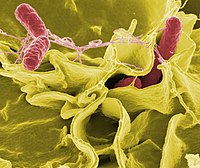
Photo from wikipedia
Laboratory assays that can accurately distinguish recent (occurring within the past year) from long-standing (>1 year) HIV infection are crucial for understanding HIV transmission dynamics in a population. However, often… Click to show full abstract
Laboratory assays that can accurately distinguish recent (occurring within the past year) from long-standing (>1 year) HIV infection are crucial for understanding HIV transmission dynamics in a population. However, often these efforts are confounded by inaccurate HIV diagnosis and the presence of HIV-2 in the population being surveyed. This study describes development of a multiplex assay that can simultaneously perform HIV diagnosis, HIV serotyping, and detection of recent HIV-1 infection in a single well. HIV diagnosis and HIV-2 serotyping were accomplished by coupling beads with an HIV-1 p24-gp41 fusion protein and HIV-2 peptide from gp36 immunodominant region, respectively. HIV-1 recent infection detection was accomplished by coupling beads with limiting amounts of multi-subtype gp41 immunodominant protein, recombinant immunodominant region, group M (rIDR-M). Assay conditions, including concentration of coupled antigens, were systematically optimized using well-characterized specimens with known HIV-status (positive or negative), HIV-2 specimens, and recent or long-term HIV-1 classification based on LAg-Avidity enzyme immunoassay (EIA) in a stepwise manner. Beads were then combined in a multiplex assay to evaluate its performance using large panel of specimens (n = 1,500) that included HIV-1 positive (n = 570, recent = 78, long-term = 492), HIV-2 positive (n = 31), and seronegative individuals (n = 899). The diagnostic component of the assay performed with high sensitivity (99.8%) and specificity (99.7%), while the HIV-2 serotyping sensitivity and specificity were 96.7% and 100%, respectively. There was a high correlation (R = 0.84) between the LAg-Avidity EIA and the multiplex assay for recent infection detection. The assay showed high inter- and intra-assay reproducibility with %coefficient of variation of <10% in the dynamic range. The multiplex assay has the ability to diagnose HIV infection, perform serotyping, and detect and distinguish recent from long-term HIV infections, all in a single well. This novel assay has the potential to simplify HIV surveillance by reducing the multiple steps that are otherwise required.
Journal Title: AIDS research and human retroviruses
Year Published: 2018
Link to full text (if available)
Share on Social Media: Sign Up to like & get
recommendations!